Cheaper means a lower price than another option. The most affordable is the lowest. We understand your quest for the best value. Let’s explore cheaper or cheapest.
Finding cheap options is crucial today. The economy requires it. The words used to discuss prices can significantly impact your choices. This is true if you’re budgeting for groceries. It’s also true if you plan a vacation or search for deals online. Cheaper and Cheapest are often used interchangeably. But they have different meanings.
The difference is crucial. It helps consumers make informed financial choices. By picking the cheapest option, you’re selecting the one with the lowest price. Choosing a more affordable option means picking a less costly one. But it’s only sometimes the cheapest one. Understanding the cost differences. This can lead to more brilliant buys. It’s crucial for savvy shoppers. They must be budget-conscious. It can lead to savings over time.

The Psychology of Smart Shopping
Smart shopping is about more than finding the lowest price. It’s not just about the cheapest tags. It involves understanding the subtleties of good value and quality purchases. Shoppers today want to make good choices. They want to maximize satisfaction. They also want to cut regrets. Psychological factors greatly influence this process.
The illusion of getting a deal
Everyone loves feeling like a savvy shopper. Retailers know this. They often create urgency with limited-time offers. Bright sale signs and timers trigger emotions. These stimulate impulsivity rather than rational thought. Shoppers believe they’re saving money. This lights up the brain’s reward pathways. But are these deals really about saving, or are we just spending on items we don’t need?
Decision-making in value shopping
They are making wise choices while shopping is crucial. Shoppers must know the difference. It’s between price and value. Low-cost items can be appealing, but are they of good quality? Will they last? Buying a pricier product might be brilliant. It is worth it if it offers better satisfaction and lasts longer. This decision-making requires analysis and foresight. Savvy shoppers weigh the cost now. They compare it to the value over time.
To be savvy in shopping, you must understand these dynamics. It’s about making informed decisions. They lead to real value for money. The cheapest option is only sometimes the wisest. Conversely, expensive sometimes means better. Shopping smart is a skill. It gets better with experience and knowledge.

Budgeting before buying
Thinking smart about money is critical to getting the best deal. Picture a full piggy bank and a happy wallet. Ready to dive into the art of stretching your dollars? Let’s discuss setting financial boundaries. Let’s also line up our spending ducks.
Everyone loves a good bargain. Finding the ‘cheapest’ is about more than just the lowest price tag. It’s about making intelligent choices. It’s with your hard-earned cash.
Setting Financial Limits
Money talks, but do we listen? Start with a clear budget. Knowing your limit is step one, whether you have a lot or a little. Staying within this limit saves you from money problems. It’s like building a fence to keep your money monsters in check.
Table Representing Financial Limits Examples:
| Income | Necessities | Savings | Extras |
|---|---|---|---|
| $2000 | $1200 | $500 | $300 |
| $3000 | $1800 | $800 | $400 |
Expense Prioritization Techniques
What to pay for first? Let’s start with needs before wants. Food, shelter, and bills top the list. Let’s break this down:
Bullet-Point List for Expense Prioritizing
- Essentials First: Rent, groceries, utilities, transport.
- Debt Payments: Keep these in check to avoid extra fees.
- Savings Goals: Set cash aside for the big dreams.
- Fun Money: The left-over cash is your ticket to treats.
Hope stays high when pennies are pinched right. Let’s embrace being budget-savvy. Let’s chart a smooth course through spending. Every penny counts. Every saving choice matters.
The Hunt for deals and discounts
Intelligent shoppers love the thrill. They love finding the best deals and discounts. Everyone wants to spend less and save more. Hunting for bargains is not just a necessity but an art.
Timing Purchases to Save Money
Knowing the right time to buy can lead to significant savings. Here’s how:
- End-of-season sales: Buy winter clothes in spring or summer gear in fall.
- Watch for when electronics and cars change models.
- Best prices often come with holiday sales and long weekends.
Keep track of price trends for more significant items. Buy when prices drop.
| Month | Item | Typical Discount |
|---|---|---|
| January | Furniture | Up to 50% |
| November | Electronics | 20-40% |
Navigating Sales and Coupons
Be a coupon wizard:
- Get coupons from sources. These include newspapers and websites.
- Combine coupons with sales for the best deal.
- Stay organized with a coupon binder or digital app.
Learn store policies. Some stores match competitor prices. They also accept expired coupons. Sign up for loyalty programs to get extra discounts and rewards.
Quality Versus Quantity: Making the Right Choice
Choosing between quality and quantity takes time. It can take effort. Consider buying something more expensive. It will last longer. It’s about finding the balance that works best for you. The right choice saves money and headaches over time. Let’s dive into how that works.
Long-term Cost-benefit Analyses
Spending wisely is about more than just picking the lowest price tag.
- Initial Savings: A low cost may look tempting, but it only sometimes wins.
- Lasting Value: Higher quality items last longer.
- Replacement Costs: Cheaper goods may need quick replacements. This adds to the expense.
Picture this: A cheap school bag might tear in months, but a sturdier one stays for years. The cost over time? The sturdy bag is the real deal with savings in multiples.
When Cheapest Isn’t the Best
Low cost can sometimes mean low quality. But it’s more than that.
| Factor | Cheap | Valuable |
|---|---|---|
| Materials | May wear quickly | Designed to last |
| Performance | Could disappoint | Consistently reliable |
| Satisfaction | Less, due to issues | Moreover, due to durability |
A toy car that breaks easily causes a child’s smile to fade quickly. A well-made one brings joy for years, and that’s priceless. Remember, the cheapest option may only fill the void. It will create more.
Online shopping: a goldmine for savings
Scoring the best deal feels like finding treasure. Online shopping offers endless discounts. Learn how to dig deep and take advantage of every digital coupon, price drop, and sale. Keep reading. You will unlock the savings potential of the internet.
Comparing prices with digital tools
Never pay the total price again. Digital tools simplify price comparisons. Use browser extensions or apps. They automatically check for lower prices. Save without the extra effort.
- Honey: Automatically applies best coupons at checkout.
- InvisibleHand: It notifies when items are cheaper on other sites.
- CamelCamelCamel: Tracks Amazon product price history.
Mastering E-commerce Platforms
Achieve savings mastery. Learn about each platform’s unique deals. Subscribe to newsletters for its secret sales. Join loyalty programs for exclusive discounts.
| Platform | Strategy |
|---|---|
| Amazon | Check the ‘Today’s Deals’ section daily |
| eBay | Search for auctions ending soon with no bids |
| Etsy | Message sellers for custom discount codes |

Negotiating Prices and When to Walk Away
Finding that balance between a good deal and a wrong buy can be tricky. It’s all about when to haggle and when to say no. Let’s dive into the details of negotiating prices. We’ll also talk about when to leave an offer that isn’t serving you.
The Art of Haggling Explained
Negotiating doesn’t have to be daunting. Think of it as a dance where both partners must move together. Start by researching the item you want. Know its average cost. This knowledge is your power.
Always remain polite and open to counteroffers. Come prepared with reasons to justify a lower price. Point out if the item isn’t brand-new or has minor flaws. Or you could buy in bulk. These are solid points for scoring a discount.
- Start low but fair.
- Wait for the response.
- If agreed, close the deal. If not, ready your next offer.
Recognizing When to Abandon a Bad Deal
Not all negotiations lead to wins. Sometimes, it’s best to walk away. If the seller won’t budge on the price and you feel it’s too high, trust your instinct. Watch out for red flags. These include pressure tactics. Also, the product’s condition needs to be more transparent.
- Trust your research.
- Avoid emotional attachment to the item.
- If it doesn’t feel right, be ready to leave.
Remember, a good deal is beneficial for both sides. Always aim for more. But, know when the cost is too high. It’s your wallet that will thank you.
Frequently Asked Questions for Cheaper Or Cheapest
Is it always best to choose the cheapest option?
Choosing the cheapest option can save money. But there are better choices than the most affordable option. Consider quality, durability, and overall value. Spending a bit more at first can lead to long-term savings. This is because of better reliability. And fewer replacements.
How to Find the Best Cheaper Products?
To find the best cheap products, compare prices at many stores. Also, check for discounts or coupons and read reviews. Pay attention to the warranty and return policies. Opt for products with a good balance of cost and quality.
What are the risks of buying the cheapest?
Choosing the cheapest often means compromising quality. This makes products break sooner. It leads to extra costs for repairs or replacements. You might also need better customer service or warranties.
Can cheaper be environmentally friendly?
Yes, cheaper products can be eco-friendly. This is true if they are made of sustainable materials and have a low carbon footprint. But it would help if you researched how committed the brand is to sustainability. Also, think about how long the products last.
Conclusion
Choosing between the Cheaper and Cheapest options requires thought. Factor in long-term value versus immediate savings. Remember, being cost-effective is critical. It’s not just about the price. Balancing quality and cost will be an intelligent choice. It will fit your wallet and needs.
Stay informed, and shop smart!


